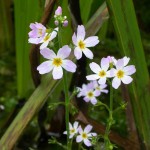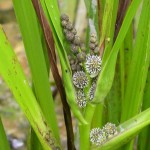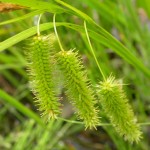Chris Bucke led a field trip at Theale on the evening of Thursday 7th June. The rain ceased in the late afternoon after about 24 hours of stormy weather. Nine intrepid members and guests met at Theale church and explored areas adjacent to the footpath through the golf-course to Malpas. In the early stages of the walk it was apparent that wet vegetation has wetting power superior to that of running water but the discomfort was forgotten when the (normally) wet areas were reached. The surface of the ditch between the footpath and the M4 was completely covered with Common Duckweed (Lemna minor) and there were fine displays of Flag Irises (Iris pseudacorus). Many more of these were noted during the walk.
Once the golf course had been reached, really interesting species were noted in ditches and ponds beside tees and greens. The first pond had around 50 spikes of Water Violet (Hottonia palustris), Greater Reed Mace (Typha latifolia), Hemlock Water Dropwort (Oenanthe crocata) Fool’s Water Cress (Apium nodiflorum) ,a pondweed (Poamogetum sp.) and various sedges as well as commoner species of wet areas. After passage through another area of very wet grass, Blossomend Copse was reached. This apparently interesting ancient woodland is surrounded, in effect, by a moat. Nightingales have been noted there but we heard none singing: conspicuous plants there were Primroses (Primula vulgaris) and Wood Spurge (Euphorbia amydaloides). Further on, more ponds and ditches provided further spikes of Water Violet and some quantity of Mare’s Tail (Hippuris vulgaris), a few Branched Bur-reeds (Sparganium erectum) , Common Spike-rush (Eleocharis palustris), the beautiful “dangly” Cyperus Sedge (Carex pseudocyperus) and other less conspicuous sedges.
The party returned to Theale through North Street, lamenting the closure of the Thatchers Arms and noting a striking population of the garden escape Oriental Poppy (Papaver orientalis) by the roadside. On a nice warm, sunny, still June evening more species would have been noted.
Report by Chris Bucke
Pictures by Jan Haseler



